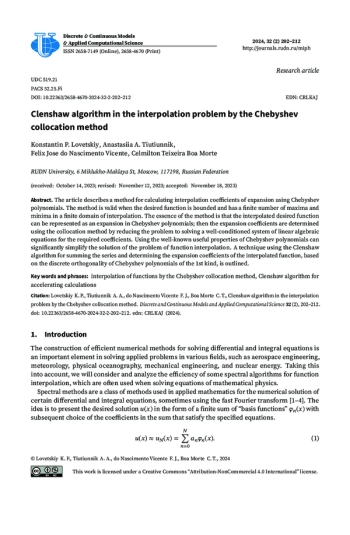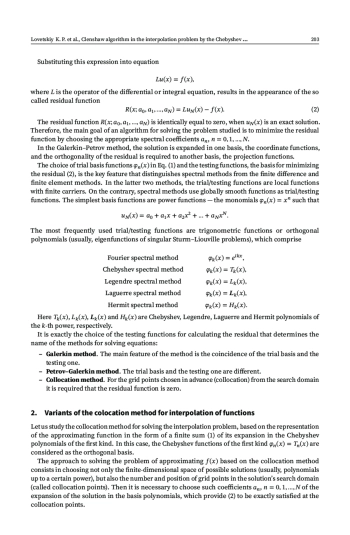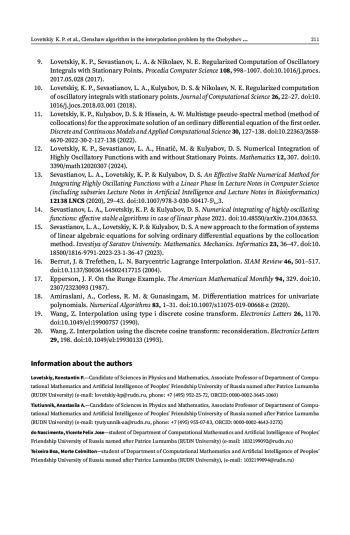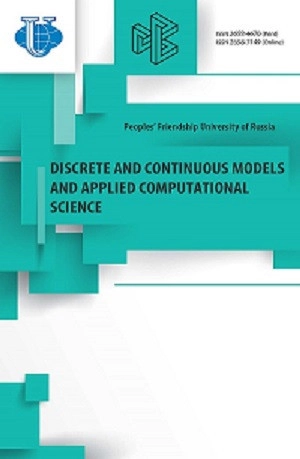The article describes a method for calculating interpolation coefficients of expansion using Chebyshev polynomials. The method is valid when the desired function is bounded and has a finite number of maxima and minima in a finite domain of interpolation. The essence of the method is that the interpolated desired function can be represented as an expansion in Chebyshev polynomials; then the expansion coefficients are determined using the collocation method by reducing the problem to solving a well-conditioned system of linear algebraic equations for the required coefficients. Using the well-known useful properties of Chebyshev polynomials can significantly simplify the solution of the problem of function interpolation. A technique using the Clenshaw algorithm for summing the series and determining the expansion coefficients of the interpolated function, based on the discrete orthogonality of Chebyshev polynomials of the 1st kind, is outlined.
Идентификаторы и классификаторы
The construction of efficient numerical methods for solving differential and integral equations is an important element in solving applied problems in various fields, such as aerospace engineering, meteorology, physical oceanography, mechanical engineering, and nuclear energy. Taking this into account, we will consider and analyze the efficiency of some spectral algorithms for function interpolation, which are often used when solving equations of mathematical physics.
Список литературы
1. Boyd, J. P. Chebyshev and Fourier Spectral Methods: Second Revised Edition. Dover Books on Mathematics (Courier Corporation, 2013).
2. Fornberg, B. A practical guide to pseudospectral methods doi:10 . 1017 / cbo9780511626357 (Cambridge University Press, 1996).
3. Mason, J. C. & Handscomb, D. C. Chebyshev Polynomials in Chebyshev Polynomials (Chapman and Hall/CRC Press, 2002).
4. Orszag, S. A. Comparison of Pseudospectral and Spectral Approximation. Studies in Applied Mathematics 51, 253–259. doi:10.1002/sapm1972513253 (1972).
5. Clenshaw, C. W. A note on the summation of Chebyshev series. Mathematics of Computation 9, 118–120. doi:10.1090/S0025-5718-1955-0071856-0 (1955).
6. Fox, L. & Parker, I. B. Chebyshev polynomials in numerical analysis (Oxford, 1968).
7. Shen, Z. & Serkh, K. Is polynomial interpolation in the monomial basis unstable? 2023. doi:10. 48550/arXiv.2212.10519.
8. Zhang, X. & Boyd, J. P. Asymptotic Coefficients and Errors for Chebyshev Polynomial Approximations with Weak Endpoint Singularities: Effects of Different Bases 2021. doi:10.48550/arXiv.2103.11841.
9. Lovetskiy, K. P., Sevastianov, L. A. & Nikolaev, N. E. Regularized Computation of Oscillatory Integrals with Stationary Points. Procedia Computer Science 108, 998–1007. doi:10.1016/j.procs. 2017.05.028 (2017).
10. Lovetskiy, K. P., Sevastianov, L. A., Kulyabov, D. S. & Nikolaev, N. E. Regularized computation of oscillatory integrals with stationary points. Journal of Computational Science 26, 22–27. doi:10. 1016/j.jocs.2018.03.001 (2018).
11. Lovetskiy, K. P., Kulyabov, D. S. & Hissein, A. W. Multistage pseudo-spectral method (method of collocations) for the approximate solution of an ordinary differential equation of the first order. Discrete and Continuous Models and Applied Computational Science 30, 127–138. doi:10.22363/2658- 4670-2022-30-2-127-138 (2022).
12. Lovetskiy, K. P., Sevastianov, L. A., Hnatič, M. & Kulyabov, D. S. Numerical Integration of Highly Oscillatory Functions with and without Stationary Points. Mathematics 12, 307. doi:10. 3390/math12020307 (2024).
13. Sevastianov, L. A., Lovetskiy, K. P. & Kulyabov, D. S. An Effective Stable Numerical Method for Integrating Highly Oscillating Functions with a Linear Phase in Lecture Notes in Computer Science (including subseries Lecture Notes in Artificial Intelligence and Lecture Notes in Bioinformatics) 12138 LNCS (2020), 29–43. doi:10.1007/978-3-030-50417-5\_3.
14. Sevastianov, L. A., Lovetskiy, K. P. & Kulyabov, D. S. Numerical integrating of highly oscillating functions: effective stable algorithms in case of linear phase 2021. doi:10.48550/arXiv.2104.03653.
15. Sevastianov, L. A., Lovetskiy, K. P. & Kulyabov, D. S. A new approach to the formation of systems of linear algebraic equations for solving ordinary differential equations by the collocation method. Izvestiya of Saratov University. Mathematics. Mechanics. Informatics 23, 36–47. doi:10. 18500/1816-9791-2023-23-1-36-47 (2023).
16. Berrut, J. & Trefethen, L. N. Barycentric Lagrange Interpolation. SIAM Review 46, 501–517. doi:10.1137/S0036144502417715 (2004).
17. Epperson, J. F. On the Runge Example. The American Mathematical Monthly 94, 329. doi:10. 2307/2323093 (1987).
18. Amiraslani, A., Corless, R. M. & Gunasingam, M. Differentiation matrices for univariate polynomials. Numerical Algorithms 83, 1–31. doi:10.1007/s11075-019-00668-z (2020).
19. Wang, Z. Interpolation using type i discrete cosine transform. Electronics Letters 26, 1170. doi:10.1049/el:19900757 (1990).
20. Wang, Z. Interpolation using the discrete cosine transform: reconsideration. Electronics Letters 29, 198. doi:10.1049/el:19930133 (1993).
Выпуск
Другие статьи выпуска
In recent years, artificial intelligence methods have been developed in various fields, particularly in education. The development of computer systems for student learning is an important task and can significantly improve student learning. The development and implementation of deep learning methods in the educational process has gained immense popularity. The most successful among them are models that consider the multimodal nature of information, in particular the combination of text, sound, images, and video. The difficulty in processing such data is that combining multimodal input data by different channel concatenation methods that ignore the heterogeneity of different modalities is an inefficient approach. To solve this problem, an inter-channel attention module is proposed in this paper. The paper presents a computer vision-linguistic system of student learning process based on the concatenation of multimodal input data using the inter-channel attention module. It is shown that the creation of effective and flexible learning systems and technologies based on such models allows to adapt the educational process to the individual needs of students and increase its efficiency.
A number of initial boundary-value problems of classical mathematical physics is generally represented in the linear operator equation and its well-posedness and causality in a Hilbert space setting was established. If a problem has a unique solution and the solution continuously depends on given data, then the problem is called well-posed. The independence of the future behavior of a solution until a certain time indicates the causality of the solution. In this article, we established the well-posedness and causality of the solution of the evolutionary problems with a perturbation, which is defined by a quadratic form. As an example, we considered the coupled system of the heat and Maxwell’s equations (the microwave heating problem).
The problem of identifying deterministic cause-and-effect relationships, initially hidden in accumulated empirical data, is discussed. Statistical methods were used to identify such relationships. A simple mathematical model of cause-and-effect relationships is proposed, in the framework of which several models of causal dependencies in data are described – for the simplest relationship between cause and effect, for many effects of one cause, as well as for chains of cause-and-effect relationships (so-called transitive causes). Estimates are formulated that allow using the de Moivre–Laplace theorem to determine the parameters of causal dependencies linking events in a polynomial scheme trials. The statements about the unambiguous identification of causeandeffect dependencies that are reconstructed from accumulated data are proved. The possibilities of using such data analysis schemes in medical diagnostics and cybersecurity tasks are discussed.
As the standardization of 5G New Radio (NR) systems operating in micro- and millimeter-wave frequency bands is over, scientific and industrial communities have begun to address the question of what 6G communications systems might or should be. While technological specifics are still in their early development phase, there is a common agreement that these systems will utilize the lower part of the terahertz band, namely, 100–300 GHz. This band poses a number of specific challenges for system designers, including the effects related to channel characteristics and the conceptually new requirements for electronics. This paper aims to report the current state-of-the-art channel characterization and communications system design. With respect to the former, we consider dynamic human body blockages and micromobility impairments. For the latter, we mainly concentrate on the physical layer devices for direct conversion schemes and the design of the so-called reconfigurable intelligent surfaces that will potentially serve as a cost-efficient blockage mitigation technique.
We introduce a numerical method to solve the two-dimensional time-dependent Schrödinger equation, which characterizes a system of two atoms with a finite-range interaction potential confined within a harmonic oscillator trap. We choose a Gaussian-shaped potential for the interaction potential. Such a system has been previously studied analytically, except that a zero-range interaction potential was used instead. We observe a strong agreement between the results for the two types of interactions. Also, we investigate the one-dimensional time-dependent Schrödinger equation for the relative motion and compute the ground state energy level as a function of the coupling strength.
This work is the first part of a large bibliographic review of active queue management algorithms of the Random Early Detection (RED) family, presented in the scientific press from 1993 to 2023. The third part will provide data on algorithms published from 2016 to 2023.
In the paper, a retrial queueing system of
We describe the system of ethical disclaimers being introduced in the journal.
Статистика статьи
Статистика просмотров за 2025 год.
Издательство
- Издательство
- РУДН
- Регион
- Россия, Москва
- Почтовый адрес
- 117198, г. Москва, ул. Миклухо-Маклая, д. 6
- Юр. адрес
- 117198, г Москва, Обручевский р-н, ул Миклухо-Маклая, д 6
- ФИО
- Ястребов Олег Александрович (РЕКТОР)
- E-mail адрес
- rector@rudn.ru
- Контактный телефон
- +7 (495) 4347027
- Сайт
- https://www.rudn.ru/















